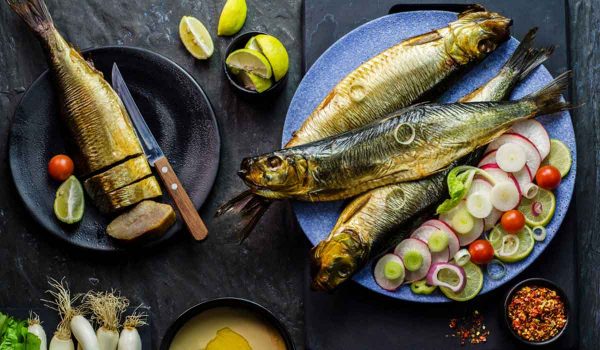 تحتل تغذية المرأة أهمية خاصة أثناء فترة الحمل، وذلك لتأثير غذاء الحامل المباشر على نمو وصحة جنينها، وأحيانًا ما يثار الكثير من الجدل حول مدى أمان تناول بعض الأطعمة للحامل مثل الرنجة التي تنتشر في بعض البلاد العربية ومنها مصر بشكل خاص، لذلك تابعي المقال التالي لمعرفة فوائد وأضرار اكل الرنجة للحامل .
تحتل تغذية المرأة أهمية خاصة أثناء فترة الحمل، وذلك لتأثير غذاء الحامل المباشر على نمو وصحة جنينها، وأحيانًا ما يثار الكثير من الجدل حول مدى أمان تناول بعض الأطعمة للحامل مثل الرنجة التي تنتشر في بعض البلاد العربية ومنها مصر بشكل خاص، لذلك تابعي المقال التالي لمعرفة فوائد وأضرار اكل الرنجة للحامل .
فوائد اكل الرنجة للحامل
تعتبر الأسماك الزيتية مثل الرنجة مصدرًا جيدًا للدهون الأساسية اللازمة للحوامل، فهي مصدر جيد للفيتامينات الأساسية المختلفة، مثل الكالسيوم، والمغذيات، وأحماض أوميغا 3 الدهنية المطلوبة للجنين والأم، لذلك من المهم تضمين تلك الأسماك في النظام الغذائي للحامل.
القيمة الغذائية لسمك الرنجة
يحتوي 85 جرام من الرنجة على حوالي 135 سعرة حرارية، و 15 جرام من البروتين، و 8 غرامات من الدهون، ولكن فقط 20 ٪ من تلك الدهون تكون من النوع المشبع، كما أن الرنجة أيضًا تحتوي على نسبة عالية من السيلينيوم، وأحماض أوميغا 3 الدهنية، وفيتامين ب، وفيتامين د، والحديد، والمغنيسيوم، والكالسيوم، والبوتاسيوم.
تعليمات هامة عند أكل سمك الرنجة للحامل
معظم الأسماك آمنة للأكل أثناء الحمل، شريطة طهيها بشكل صحيح، واتباع التعليمات التالية:
- يجب طهي الرنجة بشكل جيد وتعريضها لدرجة حرارة مرتفعة لقتل الميكروبات والبكتيريا التي يمكن أن تضر بالحمل، كما يجب تجنب تناول الرنجة المدخنة.
- عند إيقاف الحرارة عن الفرن، اترك السمك بداخل الفرن لمدة ثلاث دقائق إلى أربع دقائق، لضمان إتمام الطهي.
- يمكن استخدام مقياس حرارة الطعام للتأكد من أن المأكولات البحرية وصلت إلى درجة حرارة لا تقل عن 63 درجة مئوية، للتأكد من أنها مطبوخة وجاهزة للأكل.
أضرار اكل الرنجة للحامل
على الرغم من القيمة الغذائية المرتفعة للأسماك الزيتية مثل الرنجة، ولكن تحتوي الأسماك الدهنية على ملوثات بيئية مثل مركبات ثنائي الفينيل متعدد الكلور PCBs، ومركبات الديوكسين ومبيدات الآفات، والملوثات الأخرى، لذلك يجب على النساء الحوامل الحد من تناول هذه الأسماك إلى مرتين في الأسبوع.
هناك بعض الأراء التي تسمح للحوامل بأكل السمك المدخن، ولكن بعد طهيه وتعريضه للحرارة، أو من خلال إضافته كمكون لطبق آخر ولكن مطبوخ، وأيضًا بعد التأكد من سلامة مصدر السمك نفسه، ولكن ينصح الكثيرون النساء الحوامل بتجنب استهلاك السمك المدخن مثل الرنجة المدخنة لتجنب المخاطر المحتملة.
مخاطر الرنجة المدخنة
أحد أكبر مخاطر استهلاك الأسماك المدخنة هو التسمم الغذائي، فالأسماك المدخنة عرضة للتلوث بالبكتيريا والطفيليات، والأشخاص الذين يتناولون السمك المدخن مثل الرنجة المدخنة يواجهون خطر الإصابة بالتسمم الغذائي، وعلى الرغم من أن الطفيليات الموجودة في الأسماك المدخنة نادرًا ما تسبب أي مرض خطي، ولكن الأسماك المدخنة الملوثة قد تتسبب في عدم ارتياح معوي كبير.
السمك المدخن والسرطان
خطر آخر من تناول السمك المدخن مثل الرنجة المخنة هو زيادة خطر الإصابة بـ سرطان المعدة، حيث تحتوي الأسماك المدخنة على مستويات مرتفعة من النترات والنتريت وهي نواتج عملية التدخين، والمستويات المرتفعة من هذه المواد الكيميائية ترتبط بزيادة خطر الإصابة بسرطان المعدة، وهذا يعني أنه عند أكل السمك المدخن على أساس منتظم لمدة طويلة، فقد تزداد مخاطر الإصابة بسرطان المعدة.
وفي النهاية وبعد معرفتك فوائد اكل الرنجة للحامل والمخاطر المحتملة من تناولها أثناء الحمل، إذا كان لديك المزيد من التساؤلات أو الاستفسارات، يمكنك استشارة أحد أطبائنا من هنا.
